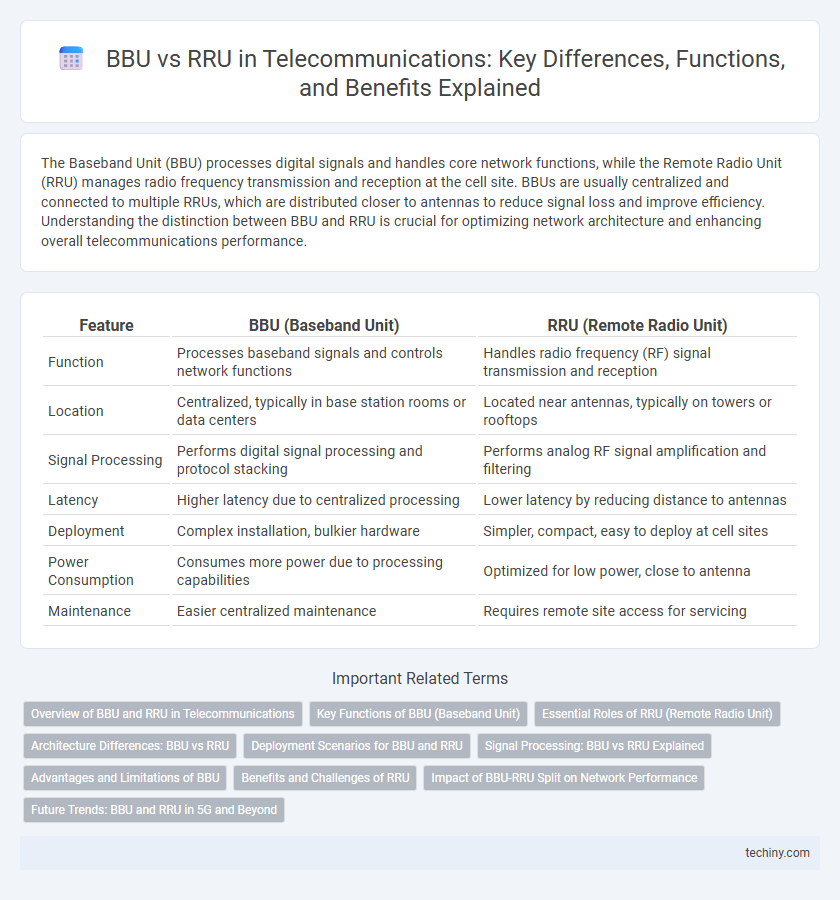The Baseband Unit (BBU) processes digital signals and handles core network functions, while the Remote Radio Unit (RRU) manages radio frequency transmission and reception at the cell site. BBUs are usually centralized and connected to multiple RRUs, which are distributed closer to antennas to reduce signal loss and improve efficiency. Understanding the distinction between BBU and RRU is crucial for optimizing network architecture and enhancing overall telecommunications performance.
Table of Comparison
| Feature | BBU (Baseband Unit) | RRU (Remote Radio Unit) |
|---|---|---|
| Function | Processes baseband signals and controls network functions | Handles radio frequency (RF) signal transmission and reception |
| Location | Centralized, typically in base station rooms or data centers | Located near antennas, typically on towers or rooftops |
| Signal Processing | Performs digital signal processing and protocol stacking | Performs analog RF signal amplification and filtering |
| Latency | Higher latency due to centralized processing | Lower latency by reducing distance to antennas |
| Deployment | Complex installation, bulkier hardware | Simpler, compact, easy to deploy at cell sites |
| Power Consumption | Consumes more power due to processing capabilities | Optimized for low power, close to antenna |
| Maintenance | Easier centralized maintenance | Requires remote site access for servicing |
Overview of BBU and RRU in Telecommunications
The Baseband Unit (BBU) processes digital signals, manages data traffic, and controls radio resources in a telecommunications network, serving as the central processing hub. The Remote Radio Unit (RRU) handles radio frequency amplification and transmission, converting digital signals from the BBU into radio waves for communication with user equipment. Together, BBUs and RRUs enhance network efficiency by distributing processing tasks and minimizing signal loss in modern cellular infrastructures.
Key Functions of BBU (Baseband Unit)
The Baseband Unit (BBU) in telecommunications processes digital signals by handling baseband signal processing, including modulation, demodulation, and error correction to ensure data integrity. It manages radio resource allocation, controls network protocols, and coordinates with Remote Radio Units (RRUs) for efficient signal transmission. BBUs also support centralized management and facilitate scalability in cellular networks by aggregating multiple RRUs.
Essential Roles of RRU (Remote Radio Unit)
The Remote Radio Unit (RRU) plays a crucial role in telecommunications by converting digital signals from the Baseband Unit (BBU) into radio frequency signals for wireless transmission. It enhances network efficiency by minimizing signal loss through proximity to the antenna and supports multiple frequency bands for flexible deployment. RRUs are essential for modern cellular systems, facilitating remote installation and reducing infrastructure costs while improving overall signal quality and coverage.
Architecture Differences: BBU vs RRU
Baseband Units (BBUs) and Remote Radio Units (RRUs) differ significantly in telecommunications architecture, with BBUs primarily handling digital signal processing, protocol management, and network coordination centrally located in the base station. RRUs are positioned closer to the antenna sites, managing radio frequency (RF) amplification and conversion, facilitating distributed antenna systems and reducing signal loss over long distances. The separation of BBU and RRU enables flexible, scalable network architecture, improving deployment efficiency and network performance in 4G and 5G networks.
Deployment Scenarios for BBU and RRU
Baseband Units (BBUs) are typically deployed in centralized locations such as data centers or telecom hubs, enabling efficient processing and management of multiple remote radio units (RRUs). Remote Radio Units (RRUs) are installed closer to the antenna sites, often on towers or rooftops, to reduce signal loss and improve transmission quality. This distributed architecture enhances network scalability, lowers latency, and optimizes coverage in dense urban and expansive rural deployment scenarios.
Signal Processing: BBU vs RRU Explained
Baseband Units (BBUs) handle complex signal processing tasks such as modulation, encoding, and baseband signal conversion, serving as the central control point in telecommunications networks. Remote Radio Units (RRUs) primarily deal with radio frequency (RF) processing, including amplification, filtering, and frequency conversion, operating closer to the antenna for efficient signal transmission. The separation of BBU and RRU tasks enhances network flexibility, reduces latency, and optimizes overall signal processing performance in modern cellular infrastructures.
Advantages and Limitations of BBU
Baseband Units (BBUs) offer centralized processing capabilities, enabling efficient management of multiple remote radio units (RRUs) and reducing operational costs through simplified maintenance. BBUs can integrate advanced features such as real-time signal processing and network coordination, improving overall network performance and scalability. Limitations include higher initial deployment costs and potential latency issues due to centralized data processing, which may impact real-time applications in certain scenarios.
Benefits and Challenges of RRU
Remote Radio Units (RRUs) offer significant benefits in telecommunications by reducing signal loss through closer proximity to antennas and enabling flexible network deployments, which enhances overall system capacity and coverage. Their compact, weather-resistant design facilitates easy installation on towers or rooftops, improving scalability and maintenance efficiency. Challenges of RRUs include higher initial costs, complex remote power management, and potential difficulties in troubleshooting due to their distributed locations.
Impact of BBU-RRU Split on Network Performance
The BBU-RRU split significantly enhances network scalability by enabling centralized baseband processing while distributing radio units closer to end-users, minimizing latency and improving signal quality. This architectural separation optimizes resource allocation and reduces the complexity of upgrades, directly boosting spectral efficiency and throughput in 4G and 5G networks. Enhanced flexibility in deployment and maintenance resulting from the split also contributes to improved network reliability and reduced operational costs.
Future Trends: BBU and RRU in 5G and Beyond
The evolution of 5G and beyond emphasizes the increasing integration of BBUs (Baseband Units) and RRUs (Remote Radio Units) through virtualization and cloud-native architectures to enhance network flexibility and scalability. Future trends include the deployment of Open RAN (Radio Access Network) frameworks, which decouple hardware and software, allowing BBUs to be centralized in cloud data centers while RRUs remain distributed closer to antennas, reducing latency and improving energy efficiency. Advances in AI-driven network management and edge computing will further optimize the collaborative performance of BBUs and RRUs, supporting ultra-reliable low-latency communications (URLLC) and massive IoT device connectivity.
BBU vs RRU Infographic

 techiny.com
techiny.com